Jul 1, 2021 | Biodiversity, Climate Change, Ecosystems
By Florian Hofhansl, researcher in the Biodiversity, Ecology, and Conservation Research Group of the IIASA Biodiversity and Natural Resources Program
Florian Hofhansl writes about a successful paper on which he was the lead author that was recently ranked #32 on the list of the Top 100 most downloaded ecology papers published in 2020.
Early in 2020, one of my manuscripts titled “Climatic and edaphic controls over tropical forest diversity and vegetation carbon storage” was accepted for publication in the prestigious journal Nature Scientific Reports.
Initially, I was worried about the bad timing when I was informed that the paper would be published on 19 March – right at the onset of the COVID-19 pandemic – since it took me and my colleagues almost a decade to collect the data and publish our results on the biodiversity and functioning of tropical forest ecosystems.
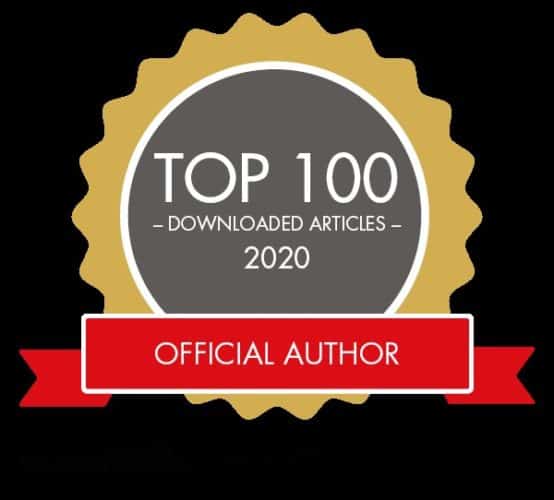 However, my worries completely disappeared when I learned that our research article had received more that 3,000 downloads, placing it among the top 100 downloaded ecology papers for Scientific Reports in 2020. This is an extraordinary achievement considering that Scientific Reports published more than 500 ecology papers in 2020. Seeing our paper positioned at #32 of the top 100 most downloaded articles in the field, therefore meant that our science was of real value to the research community.
However, my worries completely disappeared when I learned that our research article had received more that 3,000 downloads, placing it among the top 100 downloaded ecology papers for Scientific Reports in 2020. This is an extraordinary achievement considering that Scientific Reports published more than 500 ecology papers in 2020. Seeing our paper positioned at #32 of the top 100 most downloaded articles in the field, therefore meant that our science was of real value to the research community.
We kicked off our study in the dry-season of 2011 by selecting twenty one-hectare forest inventory plots at the beautiful Osa peninsula – one of the last remnants of continuous primary forest – located in southwestern Costa Rica. We did not expect that our project would receive this much scientific recognition as we were merely interested in describing the stunning biodiversity of this remote tropical region. Nevertheless, we were striving to understand the functioning of the area’s megadiverse ecosystem by conducting repeated measurements of forest characteristics, such as forest growth, tree mortality, and plant species composition.
After periodically revisiting the permanent inventory plots, and recording data for almost a decade, we found stark differences in the composition of tropical plant species such as trees, palms, and lianas across the landscape. Most interestingly, these different functional groups follow different strategies in their competition for light and nutrients, both limiting plant growth in the understory of a tropical rainforest. For instance, lianas – which are long-stemmed, woody vines – are relatively fast growing and try to reach the canopy to get to the sunlight, but they do not store as much carbon as a tree stem to reach the same height in the canopy. In contrast, palms share a different strategy and mostly stay in the lower sections of the forest where they collect water and nutrients with their bundles of palm leaves arranged upward to catch droplets and nutrients falling from above, thus reducing local resource limitation.

Lead author Florian Hofhansl and field botanist, Eduardo Chacon-Madrigal got stuck between roots of the walking palm (Socratea exorrhiza), while surveying one of the twenty one-hectare permanent inventory plots © Florian Hofhansl
Our results indicate that each plant functional group – that is, a collection of organisms (i.e., trees, palms, or lianas) that share the same characteristics – was associated with specific climate conditions and distinct soil properties across the landscape. Hence, this finding indicates that we would have to account for the small-scale heterogeneity of the landscape in order to understand future ecosystem responses to projected climate change, and thus to accurately predict associated tropical ecosystem services under future scenarios.
Our study and its subsequent uptake by the research community, illustrates the value of conducting on-site experiments that empower researchers to understand crucial ecosystem processes and applying these results in next-generation models. Research like this makes it possible for scientists to evaluate vegetation–atmosphere feedbacks and thus determine how much of man-made emissions will remain in the atmosphere and therefore might further heat up the climate system in the future.
Our multidisciplinary research project furthermore highlighted that it is crucial to gather knowledge from multiple disciplines, such as botany (identifying species), plant ecology (identifying functional strategies), and geology (identifying differences in parent material and soil types) – since all of these factors need to be considered in concert to capture the complexity of any given system, when aiming to understand the systematic response to climate change.
Read more about the research here: https://tropicalbio.me/blog
Reference:
Hofhansl F, Chacón-Madrigal E, Fuchslueger L, Jenking D, Morera A, Plutzar C, Silla F, Andersen K, et al. (2020). Climatic and edaphic controls over tropical forest diversity and vegetation carbon storage. Scientific Reports DOI: 10.1038/s41598-020-61868-5 [pure.iiasa.ac.at/16360]
Note: This article gives the views of the author, and not the position of the Nexus blog, nor of the International Institute for Applied Systems Analysis.
Sep 15, 2020 | Biodiversity, Ecosystems, Environment
IIASA researchers Michael Obersteiner, David Leclère, and Piero Visconti discuss the findings of their latest paper, which proposes pathways to reverse the current trend of biodiversity loss and shows that the next 30 years will be pivotal for the Earth’s wildlife.
Species are going extinct at an unprecedented rate. Wildlife populations have fallen by more than two-thirds over the last 50 years, according to a new report from the World Wildlife Fund. The sharpest declines have occurred throughout the world’s rivers and lakes, where freshwater wildlife has plummeted by 84% since 1970 – about 4% per year.
But why should we care? Because the health of nature is intimately linked to the health of humans. The emergence of new infectious diseases like COVID-19 tend to be related to the destruction of forests and wilderness. Healthy ecosystems are the foundation of today’s global economies and societies, and the ones we aspire to build. As more and more species are drawn towards extinction, the very life support systems on which civilization depends are eroded.
Even for hard-nosed observers like the World Economic Forum, biodiversity loss is a disturbing threat with few parallels. Of the nine greatest threats to the world ranked by the organization, six relate to the ongoing destruction of nature.
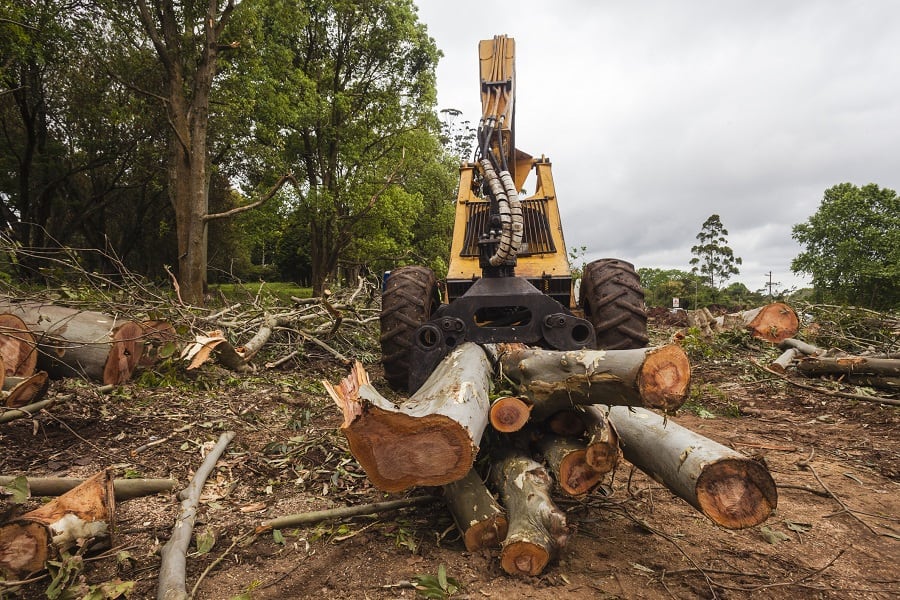
© Chris Van Lennep | Dreamstime.com
Economic systems and lifestyles which take the world’s generous stocks of natural resources for granted will need to be abandoned, but resisting the catastrophic declines of wildlife that have occurred over the last few decades might seem hopeless. For the first time, we’ve completed a science-based assessment to figure out how to slow and even reverse these trends.
Our new paper in Nature featured the work of 60 coauthors and built on efforts steered by the Intergovernmental Panel on Biodiversity and Ecosystem Services. We considered ambitious targets for rescuing global biodiversity trends and produced pathways for the international community to follow that could allow us to meet these goals.
Bending the curve
The targets of the UN Convention on Biological Diversity call for global trends of terrestrial wildlife to stop declining and start recovering by 2050 or earlier. Changes in how land is used – from pristine forest to cropland or pasture – rank among the greatest threats to biodiversity on land worldwide. So what are the necessary conditions for biodiversity to recover during the 21st century while still supporting growing and affluent human societies?
Two key areas of action stand out from the rest. First, there must be renewed ambition from the world’s governments to establish large-scale conservation areas, placed in the most valuable hotspots for biodiversity worldwide, such as small islands with species found nowhere else. These reserves, in which wildlife will live and roam freely, will need to cover at least 40% of the world’s land surface to help bend the curve from decline to recovery for species and entire ecosystems.
The location of these areas, and how well they are managed, is often more important than how big they are. Habitat restoration and conservation efforts need to be targeted where they are needed most – for species and habitats on the verge of extinction.

The next 30 years will prove pivotal for Earth’s biodiversity. Leclère et al. (2020) © IIASA
Second, we must transform our food systems to produce more on less land. If every farmer on Earth used the best available farming practices, only half of the total area of cropland would be needed to feed the world. There are lots of other inefficiencies that could be ironed out too, by reducing the amount of waste produced during transport and food processing, for example. Society at large can help in this effort by shifting towards healthier and more sustainable diets, and reducing food waste.
This should happen alongside efforts to restore degraded land, such as farmland that’s becoming unproductive as a result of soil erosion, and land that’s no longer needed as agriculture becomes more efficient and diets shift. This could return 8% of the world’s land to nature by 2050. It will be necessary to plan how the remaining land is used, to balance food production and other uses with the conservation of wild spaces.
Without a similar level of ambition for reducing greenhouse gas emissions, climate change will ensure the world’s wildlife fares badly this century. Only a comprehensive set of policy measures that transform our relationship with the land and rapidly scale down pollution can build the necessary momentum. Our report concludes that transformative changes in our food systems and how we plan and use land will have the biggest benefits for biodiversity.
But the benefits wouldn’t end there. While giving back to nature, these measures would simultaneously slow climate change, reduce pressure on water, limit nitrogen pollution in the world’s waterways and boost human health. When the world works together to halt and eventually reverse biodiversity loss, it’s not only wildlife that will thrive.
This article originally appeared on The Conversation. Read the original article here.
Note: This article gives the views of the authors, and not the position of the Nexus blog, nor of the International Institute for Applied Systems Analysis.
Aug 5, 2020 | Biodiversity, Data and Methods, Ecosystems, Young Scientists
By Martin Jung, postdoctoral research scholar in the IIASA Ecosystems Services and Management Program.
IIASA postdoc Martin Jung discusses how a newly developed map can help provide a detailed view of important species habitats, contribute to ongoing ecosystem threat assessments, and assist in biodiversity modeling efforts.
Biodiversity is not evenly distributed across our planet. To determine which areas potentially harbor the greatest number of species, we need to understand how habitats valuable to species are distributed globally. In our new study, published in Nature Scientific Data, we mapped the distribution of habitats globally. The habitats we used are based on the International Union for Conservation of Nature (IUCN) Red List habitat classification scheme, one of the most widely used systems to assign species to habitats and assess their extinction risk. The latest map (2015) is openly available for download here. We also built an online viewer using the Google Earth Engine platform where the map can be visually explored and interacted with by simply clicking on the map to find out which class of habitat has been mapped in a particular location.
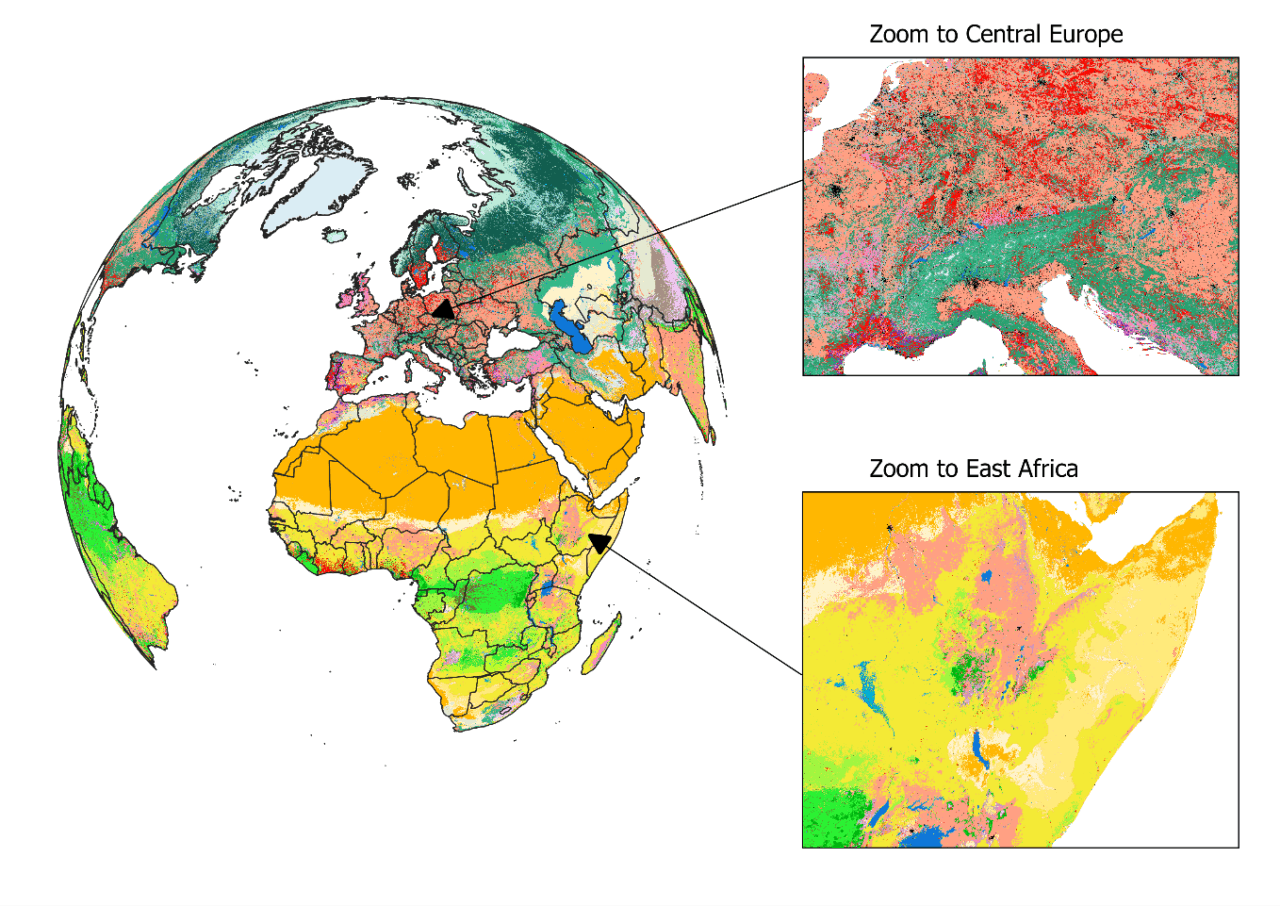
Figure 1: View on the habitat map with focus on Europe and Africa. For a global view and description of the current classes mapped, please read Jung et al. 2020 or have a look at the online interactive interface.
The habitat map was created as an intersection of various, best-available layers on land cover, climate, and land use (Figure 1). Specifically, we created a decision tree that determines for each area on the globe the likely presence of one of currently 47 mapped habitats. For example, by combining data on tropical climate zones, mountain regions and forest cover, we were able to estimate the distribution of subtropical/tropical moist mountainous rain forests, one of the most biodiverse ecosystems. The habitat map also considers best available land use data to map human modified or artificial habitats such as rural gardens or urban sites. Notably, and as a first, our map also integrates upcoming new data on the global distribution of plantation forests.
What makes this map so useful for biodiversity assessments? It can provide a detailed view on the remaining coverage of important species habitats, contribute to ongoing ecosystem threat assessments, and assist in global and national biodiversity modeling efforts. Since the thematic legend of the map – in other words the colors, symbols, and styles used in the map – follows the same system as that used by the IUCN for assessing species extinction risk, we can easily refine known distributions of species (Figure 2). Up to now, such refinements were based on crosswalks between land cover products (Figure 2b), but with the additional data integrated into the habitat map, such refinements can be much more precise (Figure 2c). We have for instance conducted such range refinements as part of the Nature Map project, which ultimately helped to identify global priority areas of importance for biodiversity and ecosystem services.
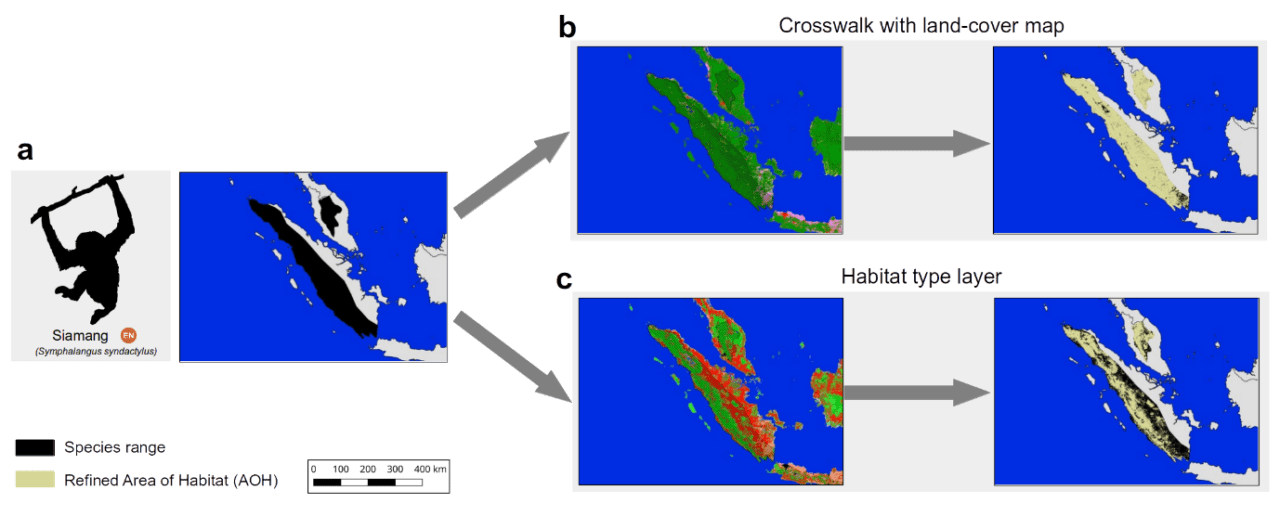
Figure 2: The range of the endangered Siamang (Symphalangus syndactylus) in Indonesia and Malaysia according to the IUCN Red List. Up to now refinements of its range were conducted based on land cover crosswalks (b), while the habitat map allows a more complete refinement (c).
Similar as with other global maps, this new map is certainly not without errors. Even though a validation has proved good accuracy at high resolution for many classes, we stress that – given the global extent and uncertainty – there are likely fine-scale errors that propagate from some of the input data. Some, such as the global distribution of pastures, are currently clearly insufficient, with existing global products being either outdated or not highly resolved enough to be useful. Luckily, with the decision tree being implemented on Google Earth Engine, a new version of the map can be created within just two hours.
In the future, we plan to further update the habitat map and ruleset as improved or newer data becomes available. For instance, the underlying land cover data from the European Copernicus Program is currently only available for 2015, however, new annual versions up to 2018 are already being produced. Incorporating these new data would allow us to create time series of the distribution of habitats. There are also already plans to map currently missing classes such as the IUCN marine habitats – think for example of the distribution of coral reefs or deep-sea volcanoes – as well as improving the mapped wetland classes.
Lastly, if you, dear reader, want to update the ruleset or create your own habitat type map, then this is also possible. All input data, the ruleset and code to fully reproduce the map in Google Earth Engine is publicly available. Currently the map is at version 003, but we have no doubt that the ruleset and map can continue to be improved in the future and form a truly living map.
Reference:
Jung M, Raj Dahal P, Butchart SHM, Donald PF, De Lamo X, Lesiv M, Kapos V,Rondinini C, & Visconti P (2020). A global map of terrestrial habitat types. Nature Scientific Data DOI: 10.1038/s41597-020-00599-8
Note: This article gives the views of the author, and not the position of the Nexus blog, nor of the International Institute for Applied Systems Analysis.
Jan 9, 2020 | Ecosystems, IIASA Network, Postdoc
By: Florian Hofhansl, postdoc in the IIASA Ecosystems Services and Management and Evolution and Ecology Programs
Florian Hofhansl shares his experience on presenting the wildfire climate impacts and adaptation model (FLAM) at the Google Exhibition Booth at the 2019 American Geosciences Union meeting held in San Francisco 9-13 December.

© Florian Hofhansl | Florian presenting the wildfire climate impacts and adaptation model (FLAM) at the Google Exhibit Booth.
The American Geosciences Union (AGU) Fall Meeting is the largest international Earth and space science meeting in the world. AGU is a great place to reconnect with colleagues as well as to build-up new professional relationships. The 2019 conference marked its Centennial in San Francisco, the home of the AGU Fall Meeting for more than 40 years, and thus I gladly took the offer to give a presentation about FLAM at the Google Exhibit Booth.
It was an honor to represent IIASA by presenting FLAM and discussing its implementation on the Google Earth Engine platform with experts face-to-face on-site. Right after the presentation I ran into a former YSSPer Sarath Guttikunda, who indicated that his experience in the IIASA Young Scientists Summer Program (YSSP) had a profound influence on his professional and personal life.
Another highlight of this year’s centennial conference edition was a presentation by Cesar Terrer, winner of the Peccei Award with Honors from the 2016 YSSP, who was invited to present a young scientists view of the future. His talk entitled “The future of earth vegetation under rising CO2” was featured in a special lighting talk session.
I have been attending the Fall Meeting since 2012 and will continue to attend this meeting for the foreseeable future as it is a great place to network with colleagues and embrace the joy of science with the community. Over the years, I keep on being inspired by other researchers filled with new perspectives, and have participated in scientific discussions that we hope will make our planet more sustainable.
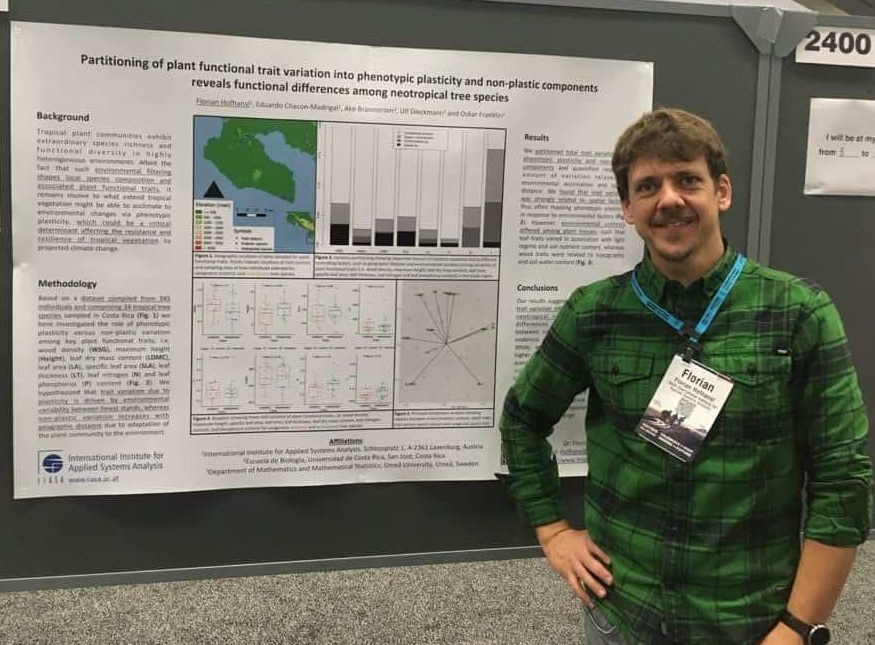
© Florian Hofhansl | Florian presenting a poster about tropical plant functional traits at AGU19.
More about Florian Hofhansl’s research can be found here: https://tropicalbio.me/blog/.
Note: This article gives the views of the author, and not the position of the Nexus blog, nor of the International Institute for Applied Systems Analysis.
Dec 4, 2019 | Ecosystems, Environment, IIASA Network
By Brian Fath, Young Scientists Summer Program (YSSP) scientific coordinator, researcher in the Advanced Systems Analysis Program, and professor in the Department of Biological Sciences at Towson University (Maryland, USA) and Soeren Nors Nielsen, Associate professor in the Section for Sustainable Biotechnology, Aalborg University, Denmark
IIASA Young Scientists Summer Program (YSSP) scientific coordinator, Brian Fath and colleagues take an extended look at the application of the ecosystem principles to environmental management in their book, A New Ecology, of which the second edition was just released.
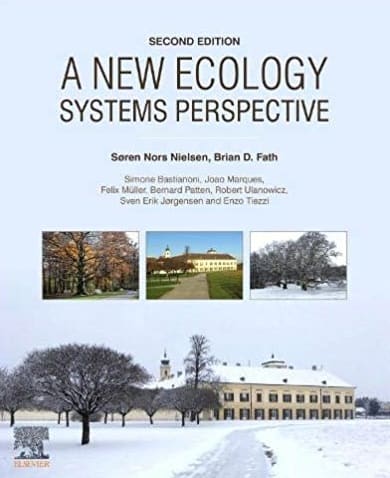 IIASA is known for some of the earliest studies of ecosystem dynamics and resilience, such as work done at the institute under the leadership of Buzz Holling. The authors of the book, A New Ecology, of which the second edition was just released, are all systems ecologists, and we chose to use IIASA as the location for one of the brainstorming meetings to advance the ideas outlined in the book. At this meeting, we crystallized the idea that ecosystem ontology and phenomenology can be summarized in nine key principles. We continue to work with researchers at the institute to look for novel applications of the approach to socioeconomic systems – such as under the current EU project, RECREATE – in which the Advanced Systems Analysis Program is participating. The project uses ecological principles to study urban metabolism – a multi-disciplinary and integrated platform that examines material and energy flows in cities as complex systems.
IIASA is known for some of the earliest studies of ecosystem dynamics and resilience, such as work done at the institute under the leadership of Buzz Holling. The authors of the book, A New Ecology, of which the second edition was just released, are all systems ecologists, and we chose to use IIASA as the location for one of the brainstorming meetings to advance the ideas outlined in the book. At this meeting, we crystallized the idea that ecosystem ontology and phenomenology can be summarized in nine key principles. We continue to work with researchers at the institute to look for novel applications of the approach to socioeconomic systems – such as under the current EU project, RECREATE – in which the Advanced Systems Analysis Program is participating. The project uses ecological principles to study urban metabolism – a multi-disciplinary and integrated platform that examines material and energy flows in cities as complex systems.
Our book argues the need for a new ecology grounded in the first principles of good science and is also applicable for environmental management. Advances such as the United Nations Rio Declaration on Sustainable Development in 1992 and the more recent adoption of the Sustainable Development Goals (2015) have put on notice the need to understand and protect the health and integrity of the Earth’s ecosystems to ensure our future existence. Drawing on decades of work from systems ecology that includes inspiration from a variety of adjacent research areas such as thermodynamics, self-organization, complexity, networks, and dynamics, we present nine core principles for ecosystem function and development.
The book takes an extended look at the application of the ecosystem principles to environmental management. This begins with a review of sustainability concepts and the confusion and inconsistencies of this is presented with the new insight that systems ecology can bring to the discussion. Some holistic indicators, which may be used in analyzing the sustainability states of environmental systems, are presented. We also recognize that ecosystems and society are physically open systems that are in a thermodynamic sense exchanging energy and matter to maintain levels of organization that would otherwise be unattainable, such as promoting growth, adaptation, patterns, structures, and renewal.
Another fundamental part of the evolution of the just mentioned systems are that they are capable of exhibiting variation. This property is maintained by the fact that the systems are also behaviorally open, in brief, capable of taking on an immense number of combinatorial possibilities. Such an openness would immediately lead to a totally indeterminate behavior of systems, which seemingly is not the case. This therefore draws our attention towards a better understanding of the constraints of the system.
One way of exploring the interconnectivity in ecosystems is taking place mainly through the lens of ecological network analysis. A primer for network environment analysis is provided to familiarize the reader with notation including worked examples. Inherent in energy flow networks, such as ecosystem food webs, the real transactional flows give rise to many hidden properties such as the rise in indirect pathways and indirect influence, an overall homogenization of flow, and a rise in mutualistic relations, while hierarchies represent conditions of both top-down and bottom-up tendencies. In ecosystems, there are many levels of hierarchies that emerge out of these cross-time and space scale interactions. Managing ecosystems requires knowledge at several of these multiple scales, from lower level population-community to upper level landscape/region.
Viewing the tenets of ecological succession through a lens of systems ecology lends our attention the agency that drives the directionality stemming from the interplay and interactions of the autocatalytic loops – that is, closed circular paths where each element in the loop depends on the previous one for its production – and their continuous development for increased efficiency and attraction of matter and energy into the loops. Ecosystems are found to show a healthy balance between efficiency and redundancy, which provides enough organization for effectiveness and enough buffer to deal with contingencies and inevitable perturbations.
Yet, the world around us is largely out of equilibrium – the atmosphere, the soils, the ocean carbonates, and clearly, the biosphere – selectively combine and confine certain elements at the expense of others. These stable/homoeostatic conditions are mediated by the actions of ecological systems. Ecosystems change over time displaying a particular and identifiable pattern and direction. Another “unpleasant” feature of the capability for change is to further evolve through collapses. Such collapse events open up creative spaces for colonization and the emergence of new species and new systems. This pattern includes growth and development stages followed by the collapse and subsequent reorganization and launching to a new cycle.
A good theory should be applicable to the concepts in the field it is trying to influence. While the mainstream ecologists are not regularly applying systems ecology concepts, the purpose of our book is to show the usefulness of the above ecosystem principles in explaining standard ecological concepts and tenets. Case studies from the general ecology literature are given relating to evolution, island bio-geography, biodiversity, keystone species, optimal foraging, and niche theory to name a few.
No theory is ever complete, so we invite readers to respond and comment on the ideas in the book and offer feedback to help improve the ideas, and in particular the application of these principles to environmental management. We see a dual goal to understand and steward ecological resources, both for their sake and our own, with the purpose of an ultimate sustainability.
Note: This article gives the views of the author, and not the position of the Nexus blog, nor of the International Institute for Applied Systems Analysis.
Oct 28, 2019 | Alumni, Ecosystems, Environment
By Bernd Lenzner, post-doctoral researcher at the Department of Botany and Biodiversity at the University of Vienna, Austria and IIASA YSSP alumnus
To guide action towards a sustainable future for nature and people, it is crucial to understand the role of invasive species in shaping global biodiversity and ecosystem services, as well as how this depends on human actions.
Imagine arriving at the shores of a country you have never visited before. What kind of nature awaits you? Will you be stunned by the beauty of plants and animals you only know from documentaries and books? Will you be fascinated by the songs of birds you’ve never heard before? Or, will you find species you know from your backyard and the landscape surrounding your home?

© Johan Larson | Dreamstime.com
Most of us probably hope to find new, untouched nature with many plants and animals we haven’t encountered yet. Isn’t that after all the purpose of exploring our planet? Unfortunately, nowadays we see that the biota in many regions of the world are becoming more and more similar as a consequence of the movement of species by humans across the globe. Recent studies have shown that approximately 4% of all plants [1], 10% of all birds [2], and 2% of all amphibians and reptiles [3] worldwide can be found in regions outside their native distribution, and these numbers are increasing with no sign of saturation [4]. Once introduced, these so-called alien species can emerge as a major threat to global biodiversity [5] and ecosystem services [6], and lead to global biotic homogenization [7].
We know that these trends are driven not only by the intentional and unintentional human introduction of species into new regions through increased trade and transport, but also by how climate and land use facilitate the establishment of species outside their native range. While these drivers are expected to largely evolve in the decades to come, researchers have so far been unable to build scenarios exploring the long-term dynamics of the distribution of alien species and their impacts.
I lead a joint study between researchers from Vienna University, IIASA, and other colleagues that was recently published in the journal BioScience [8]. In our paper, we introduced the necessary steps for building scenarios of future long-term dynamics of biological invasion at a global scale. We propose a general framework for global 21st century scenarios and models of biological invasions and review essential datasets and milestones. This is the first time that biological invasions are put into a global scenario context with the aim to develop qualitative storylines that can be linked to quantitative models.
I actually started working on this in 2017 when I was still a PhD student in the Division of Conservation Biology, Landscape, and Vegetation Ecology at the University of Vienna, and a participant in the IIASA Young Scientists Summer Program. The project helped to build bridges between research communities deeply involved in core activities from the Intergovernmental Science-Policy Platform on Biodiversity and Ecosystem Services (IPBES).
IIASA was involved in IPBES’ methodological assessment on the use of models and scenarios for biodiversity and ecosystem services and in its efforts to apply biodiversity models in existing IPCC scenarios [9] to deliver insights into the IPBES’ global assessment report released earlier this year. Recently, the IIASA Bending the curve project [10] led by David Leclère, a researcher in the Ecosystems Services and Management Program, used models to elicit what type and ambition of actions are necessary to reverse biodiversity declines, to support on-going discussions at the Convention on Biological Diversity (CBD) on a global international agreement for people and nature to be negotiated in 2020. I am a member of the IPBES expert group involved in the writing of the upcoming thematic assessment on invasive alien species and their control, and also a contributor to a new research project called AlienScenarios funded by BiodivERsA and the Belmont Forum. Led by my supervisor Franz Essl at the University of Vienna, this project will assess global and regional mid- and long-term trends of alien species richness and impacts, as well as develop scenarios for biological invasions.
In the near future, we hope to integrate these on-going projects, to allow better modeling of global biodiversity trends and their drivers, as integrating biological invasions into the global picture are required to materialize the 2050 vision of the Convention on Biological Diversity (CBD).
References
[1] van Kleunen M et al. (2015) Global exchange and accumulation of non-native plants. Nature, 525, 100-103.
[2] Dyer EE, Redding DW, Blackburn TM (2017) The global avian invasions atlas, a database of alien bird distributions worldwide. Scientific Data, 4, 170041.
[3] Capinha C, Seebens H, Cassey P, García-Díaz P, Lenzner B, Mang T, Moser D, Pyšek P, Rödder D, Scalera R, Winter M, Dullinger S, Essl F (2017) Diversity, biogeography and the global flows of alien amphibians and reptiles. Diversity and Distributions, 23, 1313-1322.
[4] Seebens H et al. (2017) No saturation in the accumulation of alien species worldwide. Nature Communications, 8, 14435.
[5] Maxwell SL, Fuller RA, Brooks TM, Watson JEM (2016) Biodiversity: The ravages of guns, nets and bulldozers. Nature, 536, 143-145.
[6] Pejchar L & Mooney HA (2009) Invasive species, ecosystem services and human well-being. Trends in Ecology and Evolution, 9, 497-504.
[7] Capinha C, Essl F, Seebens H, Moser D, Pereira HM (2015) The dispersal of alien species redefines biogeography in the Anthropocene. Science, 348, 1248-1251.
[8] Lenzner B, Leclère D, Franklin O, Seebens H, Roura-Pascual N, Obersteiner M, Dullinger S, Essf F (2019) A framework for global twenty-first century scenarios and models of biological invasions. BioScience, 69, 697-710.
[9] Kim HJ et al. (2018) A protocol for an intercomparison of biodiversity and ecosystem services models using harmonized land-use and climate scenarios. Geoscientific Model Development, 11, 4537-4562.
[10] Leclere D et al. (2018) Towards pathways bending the curve of terrestrial biodiversity trends within the 21st century. IIASA DOI:10.22022/ESM/04-2018.15241.
Note: This article gives the views of the author, and not the position of the Nexus blog, nor of the International Institute for Applied Systems Analysis.
 However, my worries completely disappeared when I learned that our research article had received more that 3,000 downloads, placing it among the top 100 downloaded ecology papers for Scientific Reports in 2020. This is an extraordinary achievement considering that Scientific Reports published more than 500 ecology papers in 2020. Seeing our paper positioned at #32 of the top 100 most downloaded articles in the field, therefore meant that our science was of real value to the research community.
However, my worries completely disappeared when I learned that our research article had received more that 3,000 downloads, placing it among the top 100 downloaded ecology papers for Scientific Reports in 2020. This is an extraordinary achievement considering that Scientific Reports published more than 500 ecology papers in 2020. Seeing our paper positioned at #32 of the top 100 most downloaded articles in the field, therefore meant that our science was of real value to the research community.









You must be logged in to post a comment.